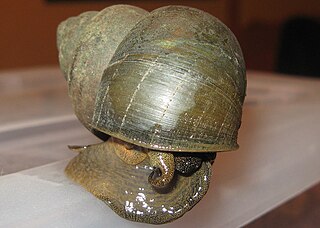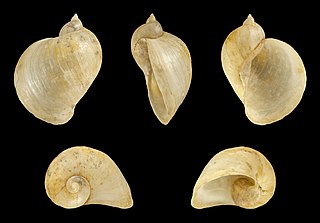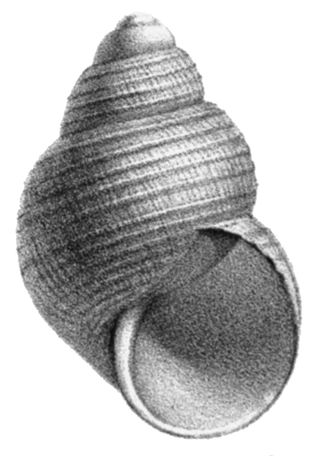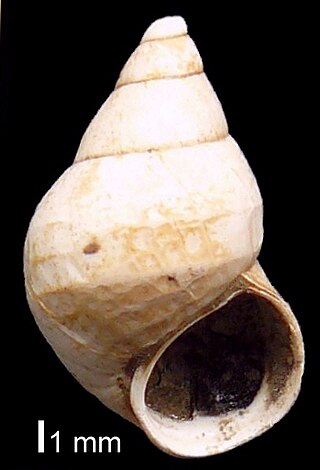Related Research Articles

Clonorchis sinensis, the Chinese liver fluke, is a liver fluke belonging to the class Trematoda, phylum Platyhelminthes. It infects fish-eating mammals, including humans. In humans, it infects the common bile duct and gall bladder, feeding on bile. It was discovered by British physician James McConnell at the Medical College Hospital in Calcutta (Kolkata) in 1874. The first description was given by Thomas Spencer Cobbold, who named it Distoma sinense. The fluke passes its lifecycle in three different hosts, namely freshwater snail as first intermediate hosts, freshwater fish as second intermediate host, and mammals as definitive hosts.

The red-rimmed melania, also known as Malayan livebearing snails or Malayan/Malaysian trumpet snails by aquarists, is a species of freshwater snail with an operculum, a parthenogenetic, aquatic gastropod mollusk in the family Thiaridae.

Galba truncatula is a species of air-breathing freshwater snail, an aquatic pulmonate gastropod mollusk in the family Lymnaeidae, the pond snails.

Theodoxus fluviatilis, common name the river nerite, is a species of small freshwater and brackish water snail with a gill and an operculum, an aquatic gastropod mollusk in the family Neritidae, the nerites.

The Chinese mystery snail, black snail, or trapdoor snail, is a large freshwater snail with gills and an operculum, an aquatic gastropod mollusk in the family Viviparidae. The Japanese variety of this species is black and usually a dark green, moss-like alga covers the shell.

Radix auricularia, the big-ear radix, is a species of medium-sized freshwater snail, an aquatic pulmonate gastropod mollusk in the family Lymnaeidae.

Elimia livescens, common name the liver elimia, is a species of freshwater snail with an operculum, an aquatic gastropod mollusk in the family Pleuroceridae.

Parafossarulus manchouricus is a species of freshwater snail with gills and an operculum, an aquatic prosobranch gastropod mollusk in the family Bithyniidae.

Parafossarulus is a genus of freshwater snails with gills and an operculum, an aquatic prosobranch gastropod mollusks in the family Bithyniidae.

Freshwater snails are gastropod mollusks that live in fresh water. There are many different families. They are found throughout the world in various habitats, ranging from ephemeral pools to the largest lakes, and from small seeps and springs to major rivers. The great majority of freshwater gastropods have a shell, with very few exceptions. Some groups of snails that live in freshwater respire using gills, whereas other groups need to reach the surface to breathe air. In addition, some are amphibious and have both gills and a lung. Most feed on algae, but many are detritivores and some are filter feeders.

Indoplanorbis is a genus of air-breathing freshwater snail. Its only member species is Indoplanorbis exustus, an aquatic pulmonate gastropod mollusk in the family Planorbidae, the ram's horn snails. The species is widely distributed across the tropics. It serves as an important intermediate host for several trematode parasites. The invasive nature and ecological tolerance of Indoplanorbis exustus add to its importance in veterinary and medical science.
Parafossarulus spiridonovi is a species of freshwater snail with gills and an operculum, an aquatic prosobranch gastropod mollusk in the family Bithyniidae.
Parafossarulus striatulus is a species of freshwater snail with gills and an operculum, an aquatic prosobranch gastropod mollusk in the family Bithyniidae.
Austropeplea viridis is a species of air-breathing freshwater snail, an aquatic pulmonate gastropod mollusk in the family Lymnaeidae, the pond snails.

Semisulcospira libertina is a species of freshwater snail with an operculum, an aquatic gastropod mollusk in the family Semisulcospiridae. Widespread in east Asia, it lives in China, Taiwan, Korea, Japan, and the Philippines. In some countries it is harvested as a food source. It is medically important as a vector of clonorchiasis, paragonimiasis, metagonimiasis and others.
Sinotaia quadrata is a species of a freshwater snail with a gill and an operculum, an aquatic gastropod mollusk in the family Viviparidae.
Assiminea lutea is a species of minute operculate snail, a marine gastropod mollusk or micromollusk in the family Assimineidae.

Sinotaia aeruginosa is a species of freshwater snail with a gill and an operculum, an aquatic gastropod mollusk in the family Viviparidae. It is widely distributed and common species in China and in northern Vietnam inhabiting various shallow freshwater habitats, where it can reach high densities. It is a keystone species in its habitat and can significantly affect water quality and phytoplankton communities. It is commonly used in Chinese cuisine.

Cipangopaludina cathayensis is a species of large, freshwater snail with an operculum and a gill, an aquatic gastropod mollusk in the family Viviparidae, the river snails.

Angulyagra polyzonata is a species of a freshwater snail with a gill and an operculum, an aquatic gastropod mollusk in the family Viviparidae.
References
- ↑ IUCN (2015). The IUCN Red List of Threatened Species. Version 2015-4. <www.iucnredlist.org>. Downloaded on 26 December 2015.
- 1 2 3 4 5 6 7 Liu Y.-Y., Li B.-Z. & Liu T.-C. (1985). "A new species and a new Chinese record of hydrobiid snails". Acta Zootaxonomica Sinica 10(1): 21-23. abstract.
- ↑ World Health Organization (1995). Control of Foodborne Trematode Infection. WHO Technical Report Series. 849. PDF part 1, PDF part 2. page 125.
- ↑ Chai J. Y., Darwin Murrell K. & Lymbery A. J. (2005). "Fish-borne parasitic zoonoses: Status and issues". International Journal for Parasitology 35(11-12): 1233-1254. doi : 10.1016/j.ijpara.2005.07.013.